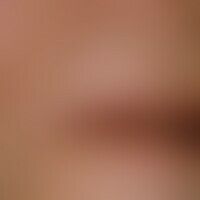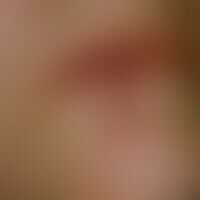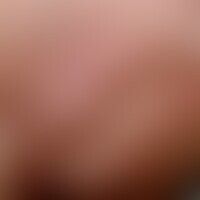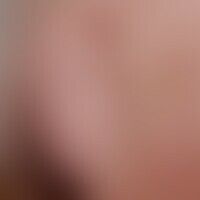Keilexzision, multi-layer Images
Go to article Keilexzision, multi-layer
Wedge excision, multi-layered. fig. 1 a: Sharply limited erosive, crusty plaque with marginal wall formation in the region of the upper lip red, spreading to the adjacent skin. a sample excision from the marginal area resulted in the histological diagnosis of a solid basal cell carcinoma. planning of a multi-layered wedge-shaped tumor excision (skin-muscle-mucosa).

Fig. 1 b: Postoperative suture course after multilayerwedge excision and layered wound closure with submucosal suture.

Fig. 1 c: Progress documentation: skin condition three years after surgery.

Keilexzision, multi-layered. fig. 2 a: Bowl-shaped, centrally erosive, inflammatory reddened tumor with marginal wall formation in the area of the lower lip in a 46-year-old woman. a tissue sample from the tumor revealed the diagnosis of a solid basal cell carcinoma. planning of a multi-layered keilexzision.

Fig. 2 b: Postoperative suture course afterwedge-shaped multi-layer excision (skin-musculature-mucosa) with W-shaped incision of the skin and layered wound closure.

Fig. 2 c: Progress documentation: skin condition 5 years after surgery.

Keilexzision, multi-layered. fig. 3 a: irregularly limited, centrally erosive tumor on the upper helix margin of a 72-year-old man, covered with fixed horny plaques and hemorrhagic crusts. histology of a tissue sample revealed a squamous cell carcinoma (pT1a G1) at the base of an actinic keratosis. planning of a three-layered keilexzision

Fig. 3 b: Approx. 1.3 cm wide defect of the helix edge after three-layer (skin-cartilage-skin)wedge excision.

Fig. 3 c: Skin condition 6 months after primary suture of a three-layerwedge excision of the auricle.

Wedge excision, multi-layered. fig. 4 a: Sharply defined nodular tumor with telangiectasia and marginal wall formation on the lower lid of a 49-year-old man. The test excision from the marginal area of the tumor revealed a solid basal cell carcinoma. Planning of a two-layered (skin-muscularis) wedge-shaped tumor resection with contralateral Burowschen's relief triangle.

Fig. 4 b: Suture conditions after two-layer tumor excision and displacement plastic surgery from the side.

Fig. 4 c: Progress documentation: skin condition 3 years after surgery.